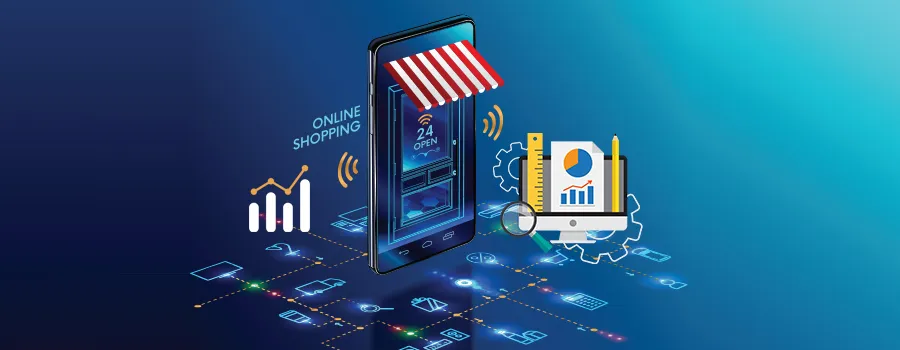Analytics in E-commerce and Indium’s Expertise
Blog: Indium Software - Big Data
The global e-commerce analytics market is expected to generate US$22.412 billion by 2025 as against from US$15.699 billion in 2019, growing at a CAGR of 6.11 per cent, according to ResearchAndMarkets.com’s report ‘Global E-Commerce Analytics Market – Forecasts from 2020 to 2025’.
Some of the key drivers will be the increasing disposable income that has led to an improving purchasing power of people. The convenience of ordering products online on e-commerce platforms and retail stores will further stimulate market growth.
To meet this growing demand and understand its customers better, e-commerce businesses are increasingly investing in advanced business intelligence and analysis tools. This can provide insights into which products are moving fast, in which markets and how to improve their operations to service the customers better, maximize profits and gain a competitive edge.
3 Focus Areas
E-commerce analytics falls into three main areas:
- Data Visualization and Descriptive Analytics: Dashboards created using historical data of customer behaviour and sales records provide snapshots of all key metrics for improved decision making
- Predictive Analytics: Using churn prediction, market-basket analysis and the like, e-commerce marketplaces can predict the demand for products and design promotions to cross-sell and upsell for improving sales and customer engagement
- Cognitive Analytics: Video and images are analysed for product classification based on predefined parameters to quickly upload new products and avoid errors and time delays associated with manual intervention
Challenges and Benefits
For e-commerce platforms and online stores of retail outlets, an understanding of which products are moving, where their customers are coming from and what their customers are saying are very important.
When a product is performing well, they can boost it further by creating suitable marketing collaterals and also pair it with likely related products to increase the overall sales and growth.
A product which is not performing well will need equal efforts to promote and special offers and discounts to increase its visibility can be designed to improve its sales.
Based on geographies, retail businesses can also plan their campaigns for their stores in those locations and step up promotions for those geographies where they have a presence but not as many footfalls.
Machine learning and artificial intelligence can be used for cross-selling and upselling of related products. For example, when someone is purchasing a mobile, relevant accessories can be displayed to encourage customers to purchase a mobile case or headphones, and so on. When a customer purchases a particular model, they can be tempted with a higher model with better and more features.
Analytics can also be used to understand conversion rates from footfall to sales and the insights used to improve the conversions. Reviews, both positive and negative, are a storehouse of information on what works and what doesn’t.
Negative Review Analytics helps to build the product line with quality to meet customer expectations. Sentiment analysis allows the e-commerce players to build on their strengths, rectify their weaknesses and retain the unsatisfied customer.
For instance, in an e-commerce site, a particular bag was very popular but soon, negative feedback started pouring in. On analysis, it was discovered that the bag was still good but a flap that was added as a design element was made of a different material that did not last long as expected. This is valuable input for the e-commerce marketplace as well as the manufacturers to improve.
Competitor analysis can also be used to devise marketing and, more importantly, pricing strategies to improve the edge over business rivals. Marketplaces and FMCG can especially benefit from this.
Use Cases
Indium used sentiment analysis for a sports retailer where the reviews were analysed to understand customer perception and feedback of the products. Indium’s proprietary data extraction tool, Tex.Ai enabled extracting key phrases to gain insights on customer views. This helped the sports retailer improve on its design and customer service.
For an e-commerce aggregator, Indium used teX.Ai to automate product classification.
Chats with customers, either on chatbot or by a customer executive over the phone can be another rich source of insight into customer satisfaction levels. Using data extraction, the discussion can be analysed for what the customer needs, how it was responded to and if it had been concluded to satisfactorily. This is crucial in building customer loyalty and training the executives and the chatbots to ensure there is a closure.
Analytics can also be used for resource optimisation to reduce the waiting time of customers trying to reach a representative.
Leverge your Biggest Asset Data
Inquire Now
Leverge your Biggest Asset Data
Indium Advantage
Indium Software, in its more than two decades of existence, has been providing holistic solutions on cutting edge technologies. It has carefully built a team that is a judicious mix of domain and technology experts.
Our e-commerce team can set up and run a marketplace from the ground up using the latest technologies including in-build analytics. It can also build solutions for analytics on existing platforms using machine learning and artificial intelligence. Strong solution architects, subject matter experts and expertise in analytics make Indium an ideal partner for e-commerce platforms and retail brands seeking to leverage the World Wide Web.
The post Analytics in E-commerce and Indium’s Expertise appeared first on Indium Software.
